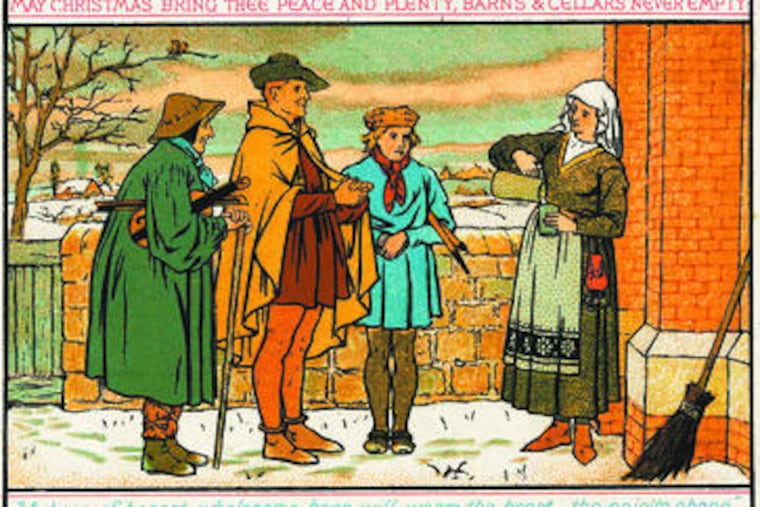Holiday greetings from years past
Historical Society of Pennsylvania offers a collection of classic cards.

Holiday greeting cards date to the introduction of paper in ancient Egypt and China. But leave it to the exhibit "Holiday Traditions" at the Historical Society of Pennsylvania to find intriguing beauty, and expressive power, in 100 such cards (mostly lithographs) from its collection.
Thanksgiving, Christmas, New Year's and Valentine's cards are plentiful here, along with very noteworthy Hanukkah cards obtained at the merger of Balch Institute with the society. Some of the cards are from as early as the mid-19th century.
Well represented, too, are examples from the Boston print shop of German immigrant Louis Prang, father of the American greeting card. Surprisingly, Victorian valentines could be sharp-tongued or mercenary, as well as sweet and sentimental; Marcus Ward & Co.'s old card "May Christmas Bring Thee Peace & Plenty" reminds us that "thee" and "thou" could still be heard on our Quaker city's streetcars in the 1930s and '40s.
This show's most inscrutable greeting card sent by a prominent Philadelphian, and apparently self-published, is "Merrie Xmas Anyway" (1938), portraying Princess Grace's father, Jack Kelly, with a donkey, man and beast behind the eight-ball.
All the cards displayed are reproductions of delicate originals, noted Michael Ryan, the show's organizer.
Jim's of Lambertville
A mainspring of the 150-piece painting show, "Thrilla in Lambertvilla XX," at Jim's is Clarence Johnson's
Lumberville Lock
(c. 1925), which demonstrates a recurring conflict between intuitive gutsiness and self-conscious finesse.
In its wintry, cavernous expanse, shapes of things billow as if in an imaginary breeze, infusing this moody oil with a necessary vitality. Also, this gives it at least a quizzical claim to seriousness as art - something another large landscape, William Lathrop's
Solebury Valley
, possesses hands down.
We're in Pennsylvania impressionist country here - Lathrop one of its pioneers, Johnson showing great promise but never as famous.
Connected with the longstanding traditions of that "school," other distinctive contributors to it here are Daniel Garber, Edward Redfield and Robert Spencer. A subdued Harry Leith-Ross snow scene is startling with its unexpected touch of pathos by one of our resolutely upbeat minor masters.
Gratz Gallery
The 80-item "Pennsylvania Painters" show at Gratz continues local tradition with George W. Sotter, Harry Leith-Ross, John Folinsbee, Rae Sloan Bredin and many other New Hope favorites.
Also notable are oil landscapes by Antonio Martino and Walter Baum, a pleasing Carl Phillip Weber seascape, and William Winner's quirky period piece about life along the Delaware River.
Especially noteworthy is Hugh Breckenridge's moody, resonant
The Valley
(1922), by a strong painter whose work is too seldom seen. With Philadelphia's major Cezanne show on deck, showing this Cezannesque Breckenridge oil is timely.
Also interesting is seeing the high caliber of the few present-day painters included in this show - most notably, Richard Lennox, a name to remember.
New Hope Arts Center
Directly across Bridge Street is an arts center display "Works in Wood" by 35 live artists. Featuring sculpture, vessels and furniture, this show feels more like browsing for interesting "finds" in a good bookstore than a formal art exhibit. It's well worth stopping by for a leisurely look.